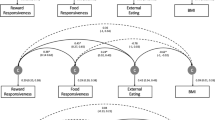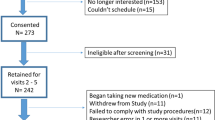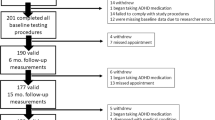Abstract
Objective:
The current study tests the influence of two factors, the obesogenic environment and impulsivity, on food intake in primary school children. Our current food environment offers a large variety of cheap and easily available sweet and fatty foods. This obesogenic environment is believed to be a cause of the recent obesity epidemic. Impulsive people are generally less successful at inhibiting prepotent responses and they are reward sensitive. We investigate whether the interaction between an obesogenic environment and an impulsive person leads to overeating.
Design:
A quasi-experimental 2 (reward sensitive versus not reward sensitive) by 2 (successful response inhibitors versus unsuccessful response inhibitors) by 2 (monotonous versus varied food environment) between-subjects design with caloric intake during a taste test as the main dependent variable. The link between impulsivity and overweight was also examined.
Subjects:
78 healthy primary school children (age: 8–10 years).
Measurements:
We measured two aspects of impulsivity: reward sensitivity and deficient response inhibition. Subsequently, one aspect of the obesogenic environment was manipulated; half of the participants received monotonous food during a bogus taste test whereas the other half tasted food that was varied in colour, form, taste and texture.
Results:
As expected, reward sensitivity interacted with variety. In the monotony group there was no difference in food intake between the less and more reward-sensitive children (183 kcal±23 s.d. versus 180 kcal±21 s.d.). However, in the variety group the more reward-sensitive children ingested significantly more calories than the less reward-sensitive children (237 kcal±30 s.d. versus 141 kcal±19 s.d.). Reward sensitivity was not linked to overweight. Deficient response inhibition did not interact with variety, but it was linked to overweight.
Conclusion:
It is suggested that reward sensitivity could be a causal mechanism for overeating in an obesogenic environment whereas prepotent response inhibition may be a maintaining factor of the problem of overeating.
This is a preview of subscription content, access via your institution
Access options
Subscribe to this journal
Receive 12 print issues and online access
$259.00 per year
only $21.58 per issue
Buy this article
- Purchase on Springer Link
- Instant access to full article PDF
Prices may be subject to local taxes which are calculated during checkout


Similar content being viewed by others
References
Flegal KM . Epidemiological aspects of overweight and obesity in the United States. Physiol Behav 2005; 86: 599–602.
Hu FB . Overweight and obesity in women: health risks and consequences. J Womens Health 2003; 12: 163–172.
Clarke WR, Lauer RM . Does childhood obesity track into adulthood? Crit Rev Food Sci Nutr 1993; 33: 423–430.
Serdula MK, Ivery D, Coates RJ, Freedman DS, Williamson DF, Byers T . Do obese children become obese adults? A review of the literature. Prev Med 1993; 22: 167–177.
Jeffery RW, Utter J . The changing environment and population obesity in the United States. Obes Res 2003; 11: 12S–22S.
Hill JO, Peters JC . Environmental contributions to the obesity epidemic. Science 1998; 280: 1371–1374.
Lowe MR, Levine AS . Eating motives and the controversy over dieting: eating les than needed versus less than wanted. Obes Res 2005; 13: 797–806.
Blundell JE, Stubbs RJ, Golding C, Croden F, Alam R, Whybrow S et al. Resistance and susceptibility to weight gain: individual variability in response to a high-fat diet. Physiol Behav 2005; 86: 614–622.
Solanto MV, Abikoff H, Sonuga-Barke E, Schachar R, Logan GD, Wigal T et al. The ecological validity of delay aversion and response inhibition as measures of impulsivity in AD/HD: a supplement to the NIHM multimodal treatment study of AD/HD. J Abnorm Child Psychol 2001; 29: 215–228.
Avila C . Distinguishing BIS-mediated and BAS-mediated disinhibition mechanisms: a comparison of disinhibition models of Gray (1981, 1987) and of Patterson and Newman (1993). J Pers Soc Psychol 2001; 80: 311–324.
Barkley RA . Behavioral inhibition, sustained attention, and executive functions: Constructing a unifying theory of ADHD. Psychol Bull 1997; 121: 65–94.
Logan GD, Schachar R, Tannock R . Impulsivity and inhibitory control. Psychol Sci 1997; 8: 60–64.
Nederkoorn C, Braet C, Van Eijs Y, Tanghe A, Jansen A . Why obese children cannot resist food: the role of impulsivity. Eat Behav 2006a; 7: 315–322.
Nederkoorn C, Smulders FTY, Havermans RC, Roefs A, Jansen A . Impulsivity in obese women. Appetite 2006b; 47: 253–256.
Nederkoorn C, Jansen E, Mulkens S, Jansen A . Impulsivity predicts treatment outcome in obese children. Behav Res Ther 2007; 45: 1071–1075.
Davis C, Levitan RD, Smith M, Tweed S, Curtis C . Associations among overeating, overweight, and attention deficit/hyperactivity disorder: a structural equation modelling approach. Eat Behav 2006; 7: 266–274.
Agranat-Meged AN, Deitcher G, Goldzweig G, Leibenson L, Stein M, Galili-Weisstub E . Childhood obesity and attention deficit/hyperactivity disorder: a newly described comorbidity in obese hospitalized children. Int J Eat Disord 2005; 37: 357–359.
Holtkamp K, Konrad K, Muller B, Heussen N, Herpertz S, Herpertz-Dahlmann B et al. Overweight and obesity in children with attention-deficit/hyperactivity disorder. Int J Obes 2004; 28: 685–689.
Guerrieri R, Nederkoorn C, Jansen A . How impulsiveness and variety influence food intake in a sample of healthy women. Appetite 2007a; 45: 119–122.
Patton JH, Stanford MS, Barratt ES . Factor structure of the Barratt Impulsiveness Scale. J Clin Psychol 1995; 51: 768–774.
Guerrieri R, Nederkoorn C, Stankiewicz K, Alberts H, Geschwind N, Martijn C et al. The influence of trait and induced state impulsivity on food intake in normal-weight healthy women. Appetite 2007b; 49: 66–73.
Williams BR, Ponesse JS, Schachar R, Logan GD, Tannock R . Development of inhibitory control across the life span. Dev Psychol 1999; 35: 205–213.
Matthys W, van Goozen SHM, de Vries H, Cohen-Kettenis PT, van Engeland H . The dominance of behavioural activation and behavioural inhibition in conduct disordered boys with or without attention deficit hyperactivity disorder. J Child Psychol Psychiatry 1998; 39: 643–651.
Carver CS, White TL . Behavioral inhibition, behavioral activation, and affective responses to impending reward and punishment: the BIS/BAS scales. J Pers Soc Psychol 1994; 67: 319–333.
Davis C, Fox J . Sensitivity to reward and body mass index (BMI): evidence for a non-linear relationship. Appetite 2008; 50: 43–49.
Author information
Authors and Affiliations
Corresponding author
Rights and permissions
About this article
Cite this article
Guerrieri, R., Nederkoorn, C. & Jansen, A. The interaction between impulsivity and a varied food environment: its influence on food intake and overweight. Int J Obes 32, 708–714 (2008). https://doi.org/10.1038/sj.ijo.0803770
Received:
Revised:
Accepted:
Published:
Issue Date:
DOI: https://doi.org/10.1038/sj.ijo.0803770
Keywords
This article is cited by
-
Investigating the relationship between inhibitory control and dietary adherence among patients with type 2 diabetes mellitus based on subjective and objective measures
Nutrition & Diabetes (2023)
-
The modulation of sustainability knowledge and impulsivity traits on the consumption of foods of animal and plant origin in Italy and Turkey
Scientific Reports (2022)
-
Implicit bias to food and body cues in eating disorders: a systematic review
Eating and Weight Disorders - Studies on Anorexia, Bulimia and Obesity (2021)
-
Behavioral and psychological factors associated with suboptimal weight loss in post-bariatric surgery patients
Eating and Weight Disorders - Studies on Anorexia, Bulimia and Obesity (2021)
-
Hypothalamus-hippocampus circuitry regulates impulsivity via melanin-concentrating hormone
Nature Communications (2019)



